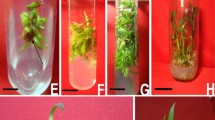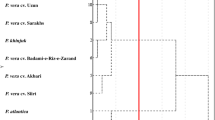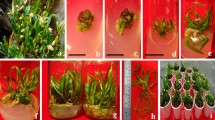Abstract
Sixty six plants raised via direct shoot bud organogenesis from pre-plasmolysed leaf explants of Catharanthus roseus were assessed under in vivo conditions for their physio-morpho traits, tryptophan metabolism, genetic fidelity and alkaloid profile. Morphologically all plants were parent like except the three morpho-types i.e. broad cup-shaped leaves, dwarf phenotype and enlarged pink corona. Vindoline was detected in most of the plants in substantial amount while ajmalicine, ajmaline and catharanthine were detected in few plants only. More than eightfold increased vindoline (0.08 % dry wt.) was showed by plant no. 1, 4 and 39. Except plant no. 54, which accumulated the highest alkaloid content of 3.09 % dry wt. with tryptophan content of 0.0283 % dry wt., majority of the plants showed a negative correlation between total alkaloid content and tryptophan accumulation and strong positive correlation between tryptophan content and 5-methyltryptophan tolerance. ISSR and RAPD profile of seventeen randomly selected, field established plants was generated by using 10 ISSR and 60 RAPD primers. In RAPD, a total of 753 bands were detected, out of which 624 (82.87 %) were monomorphic. In ISSR profiling, a total of 205 bands were detected out of which 200 bands were monomorphic (97.56 %) and only 5 bands were found to be polymorphic. Highly significant data for the monomorphic banding pattern across all the three genotypes (p < 0.01) was observed. Principal components, AMOVA analysis and multivariate analysis using Nei and Li’s coefficient further validate the monomorphism. Thirteen plants having superior traits were grown in Random Block Design in field. The relevance of physiological and epigenetic changes occurred in the light of morpho-types and alkaloid profile of directly regenerated plants during in vitro to in vivo acclimatization in C. roseus is discussed.








Similar content being viewed by others
References
Bairu MW, Aremu AO, Van Staden J (2011) Somaclonal variation in plants: causes and detection methods. Plant Growth Regul 63:147–173
Bieleski RL, Turner NA (1966) Separation and estimation of amino acids in total plant extracts by thin layer electrophoresis and chromatography. Ann Biochem 17:278–293
Canel C, Lopes-Cardoso MI, Whitmer S, van der Fits L, Pasquali G, van der Heijden R, Hoge JH, Verpoorte R (1998) Effects of over-expression of strictosidine synthase and tryptophan decarboxylase on alkaloid production by cell cultures of Catharanthus roseus. Planta 205:414–419
Choi PS, Kim YD, Choi KM, Chung HJ, Choi DW, Liu JR (2004) Plant regeneration from hairy root cultures transformed by infection with A. rhizogenes in Catharanthus roseus. Plant Cell Rep 22:823–831
Dalby A, Tsai CY (1975) Acetic anhydride requirement in the colorimetric determination of tryptophan. Ann Biochem 63:283–285
Facchini PJ, De Luca V (2008) Opium poppy and Madagascar periwinkle: model non-model systems to investigate alkaloid biosynthesis in plants. Plant J 54:763–784
Fatima S, Mujib A, Tonk D (2015) NaCl amendment improves vinblastine and vincristine synthesis in Catharanthus roseus: a case of stress signalling as evidenced by antioxidant enzymes activities. Plant Cell Tissue Org Cult 121:445–458
Frearson EM, Power JB, Cocking EC (1973) The isolation, culture and regeneration of Petunia leaf protoplast. Dev Biol 33:130–137
Goddijn OJM, Pennings EJM, van der Helm P, Schilperoort RA, Verpoorte R, Hoge JHC (1995) Overexpression of a tryptophan decarboxylase cDNA in Catharanthus roseus crown gall calluses results in increased tryptamine levels but not in increased terpenoid indole alkaloid production. Transgenic Res 4:315–323
Gupta MM, Singh DV, Tripathi AK, Pandey R, Verma RK, Singh S, Shasany AK, Khanuja SPS (2005) Simultaneous determination of vincristine, vinblastine, catharanthine and vindoline in leaves of Catharanthus roseus by high performance liquid chromatography. J Chromato Sci 43:450–453
Jain SM (2001) Tissue culture-derived variation in crop improvement. Euphytica 118:153–166
Johny L, Conlan X, Cahill D, Adholeya A (2015) in vitro and in situ screening systems for morphological and phytochemical analysis of Withania somnifera germplasms. Plant Cell Tissue Org Cult 120:1191–1202
Kaeppler SM, Kaeppler HF, Rhee Y (2000) Epigenetic aspects of somaclonal variation in plants. Plant Mol Biol 43:179–188
Khan EU, Fu XZ, Wang J, Fan QJ, Huang XS, Zhang JS, Liu JH (2009) Regeneration and characterization of plants derived from leaf in vitro culture of two sweet orange (Citrus sinensis (L.) Osbeck) cultivars. Sci Horticult 120:70–76
Khanuja SPS, Shasany AK, Darokar MP, Kumar S (1999) Rapid isolation of DNA from dry and fresh samples of plants producing large amounts of secondary metabolites and essential oils. Plant Mol Bio Rep 17:1–7
Matzke MA, Matzke AJM (1996) Stable epigenetic states in differentiated plant cells: implications for somaclonal variation and gene silencing in transgenic plants. In: Russo et al (eds) Epigenetic mechanisms of gene regulation. Cold Spring Harbor Press, Cold Spring Harbor, pp 377–392
Miguel C, Marum L (2011) An epigenetic view of plant cells cultured in vitro: somaclonal variation and beyond. J Exp Bot 62:3713–3725
Murashige T, Skoog F (1962) A revised medium for rapid growth and bioassays with tobacco tissue cultures. Physiol Plant 15:473–492
Neelakandan AK, Wang K (2012) Recent progress in the understanding of tissue culture-induced genome level changes in plants and potential applications. Plant Cell Rep 31:597–620
Nei M, Li WH (1979) Mathematical model for studying genetic variation in terms of restriction endonucleases. Pro Nat Acad Sci (USA) 76:5269–5273
Newell CA (2000) Plant transformation technology: developments and applications. Mol Biotech 16:53–65
Pan Q, Mustafa NR, Tang K, Choi YH, Verpoorte R (2015) Monoterpenoid indole alkaloids biosynthesis and its regulation in Catharanthus roseus: a literature review from genes to metabolites. Phytochem Rev. doi:10.1007/s11101-015-9406-4
Richards EJ (1997) DNA methylation and plant development. Trends Genet 13:319–323
Sharma KK, Mathur PB, Thorpe TA (2005) Genetic transformation technology: status and problems. In Vitro Cell Dev Biol ‘Plant’ 41:102–112
van der Heijden R, Jabos DJ, Snoeijer W, Hallard D, Verpoorte R (2004) The Catharanthus alkaloids: pharmacognosy and biotechnology. Curr Med Chem 11:1241–1253
Verma P, Mathur AK (2011a) Agrobacterium tumefaciens mediated transgenic plant production via direct shoot bud organogenesis from pre-plasmolyzed leaf explants of Catharanthus roseus. Biotech Lett 33:1053–1060
Verma P, Mathur AK (2011b) Direct shoot bud organogenesis and plant regeneration from leaf explants in Catharanthus roseus. Plant Cell Tissue Org Cult 106:401–408
Verma P, Mathur AK, Srivastava A, Mathur A (2012a) Emerging trends in research on spatial and temporal organization of terpenoid indole alkaloids pathway in Catharanthus roseus: a literature up-date. Protoplasma 249:255–268
Verma P, Mathur AK, Shankar K (2012b) Growth, alkaloid production, rol genes integration, bioreactor up-scaling and plant regeneration studies in transformed hairy root lines of Catharanthus roseus. Plant Biosyst 146:27–40
Verma P, Mathur AK, Shankar K (2012c) Increased availability of tryptophan in 5-methyltryptophan tolerant shoots of Catharanthus roseus and their post-harvest in vivo elicitation induces enhanced vindoline production. App Biochem Biotech 168:568–579
Verma P, Mathur AK, Masood N, Luqman S, Shankar K (2013) Tryptophan over producing cell suspensions of Catharanthus roseus (L) G. Don and their up-scaling in stirred tank bioreactor: detection of phenolic compound with antioxidant potential. Protoplasma 250:371–380
Whitmer S, van der Heijden R, Verpoorte R (2002) Effect of precursor feeding on alkaloid accumulation by a tryptophan decarboxylase over-expressing transgenic cell line T22 of C. roseus. J Biotechnol 96:193–203
Zarate R, Verpoorte R (2007) Strategies for the genetic modification of the medicinal plant Catharanthus roseus (L.) G. Don Phytochem Rev 6:475–491
Acknowledgments
This work is financially supported by The Council of Scientific and Industrial Research (CSIR), New Delhi (India) and DST-FAST TRACK SERC/LS-261/2012. The technical help rendered by Mr. Krishna Gopal and Mr. Durgesh during field experiments is also highly acknowledged.
Author information
Authors and Affiliations
Corresponding author
Rights and permissions
About this article
Cite this article
Verma, P., Khan, S.A., Mathur, A.K. et al. Tryptophan metabolism and evaluation of morphological, biochemical and molecular variations in a field grown plant population derived via direct adventitious shoot bud regeneration from pre-plasmolysed leaves of Catharanthus roseus . Plant Cell Tiss Organ Cult 123, 357–375 (2015). https://doi.org/10.1007/s11240-015-0841-0
Received:
Accepted:
Published:
Issue Date:
DOI: https://doi.org/10.1007/s11240-015-0841-0




